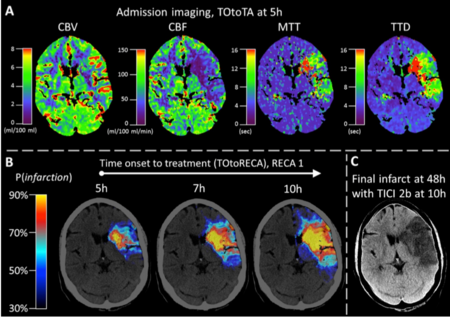Learning to Predict Stroke Outcome based on Multivariate CT Images
The treatment of acute brain strokes requires very careful decisions in a very narrow time-window. Shortly after patients are admitted to the hospital and scans have been acquired, clinicians need to decide which treatment path offers best chances survival and avoidance of brain damage. These decisions have to be based on a multitude of 3D tomographic image data (CT perfusion maps and potentially thermal imaging) and other clinical indicators (patient age, NIHSS, etc).
Novel image processing techniques, mathematical models and machine learning algorithms, which can deal with the challenges of real clinical data, will be devised, implemented and tested during this research project. A large dataset of retrospective multispectral images of stroke patients is employed for the development and training of new models.
The new algorithms will be used to derive an automatic prediction of a pixel-wise map of tissue that is likely to be recovered if a certain treatment (in particular vessel recanalisation) is performed and how urgent this intervention is. The project is being carried out in close collaboration with the neuroradiology department.

Funded by Lübeck Medical School with TRAVE Stroke Project.
Selected Publications
- Lucas C., Maier O., Heinrich M.P.
Shallow fully-connected neural networks for ischemic stroke-lesion segmentation in MRI
BVM 2017 - Maier O., Menze B.H., von der Gablentz J., Häni L., Heinrich M.P., Liebrand M., Winzeck S., Basit A., Bentley P., Chen L. et al.
ISLES 2015 - A public evaluation benchmark for ischemic stroke lesion segmentation from multispectral MRI
Medical Image Analysis 2017 - Kemmling A., Flottmann F., Forkert N.D. et al.
Multivariate dynamic prediction of ischemic infarction and tissue salvage as a function of time and degree of recanalization
Journal of Cerebral Blood Flow & Metabolism 2015
Project Team
M.Sc. Christian Lucas
Jun.-Prof. Dr. Mattias P. Heinrich
Cooperation Partners
Dr. André Kemmling, Institut für Neuroradiologie, Universitätsklinikum Schleswig-Holstein, Lübeck
Dr. Amir Madany-Mamlouk, Institut für Neuro- und Bioinformatik, Universität zu Lübeck

- Research
- AI und Deep Learning in Medicine
- Medical Image Processing and VR-Simulation
- Integration and Utilisation of Medical Data
- Sensor Data Analysis for Assistive Health Technologies
- Medical Image Computing and Artificial Intelligence
- Medical Data Science Lab
- Medical Deep Learning Lab
- Junior Research Group Diagnostics and Research of Movement Disorders
- Former Medical Data Engineering Lab
